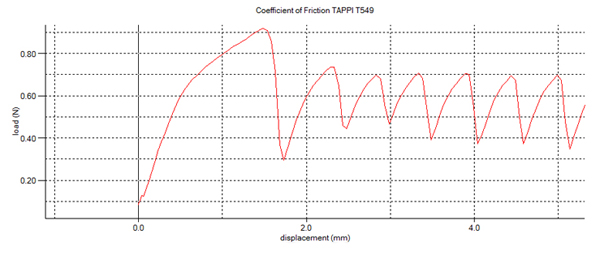 Testing Frictional Forces: Coefficient of Friction (COF)
Testing Frictional Forces: Coefficient of Friction (COF)Coefficient of friction testers for film and sheet materials typically produce figures for static coefficient of friction (the force overcome to initiate sliding movement) and the kinetic coefficient of friction (the force resisting continued sliding motion).
Friction is the product of a system, not a material. This may be paper sliding over a standardised steel surface, or two samples of the same plastic film sliding over each other. The value for coefficient of friction μ is the ratio of the force required to move one object over another, divided by the normal force applied to press the surfaces together (mass × acceleration due to gravity):
μ=F/mg
Static friction (sometimes called stiction) may be measured in a test by itself, or as an initial peak value in a sliding test from rest, through a sliding distance at a given speed, back to rest. Kinetic friction is typically measured as an average value over a sliding distance.
Values for the coefficient of friction may seem stable, but can involve very small values for F, and are affected by environmental conditions of temperature and humidity, which may exacerbate potential surface changes. Surfaces are also altered by contact that may abrade, lubricate or polish, or create adhesion (blocking). This includes handling during sample preparation and mounting, and the amount of time one surface rests on another, during which volatile additives may accumulate to form a lubricating layer, inks and coatings may adhere, or where fibres compress to exclude air.
Some standard test methods include a resting time for the sled on the bed sample, but where they do not, consistency should nonetheless be maintained.
In measuring the coefficient of friction, care must be taken not to apply an impact as the initial pulling load is applied, so as to affect the static friction value. This can be avoided by using a less-than-rigid link.
An elastic link can cause stick-slip behaviour during measurement of kinetic friction, where the relative motion between surfaces oscillates with a periodicity:

Where stick-slip is observed, a more rigid sled link is used.
Sleds may tend to rotate or slew if friction properties across the width of a sample are variable. This will affect the average values for the coefficient of kinetic friction, but may have to be accepted as a characteristic of the material under test. Testing in different orientations can therefore be important.
In practice, surfaces moving in contact may not in any case be uniform, as with printed or embossed materials, so average values are sought by comparing friction in different orientations, with samples taken from different positions in a larger sample sheet. The requirement may simply be to make handling of sheet, or sheet-constructed packaging, predictable in order to optimise throughput.
Common standards used for determining coefficient of friction values include: